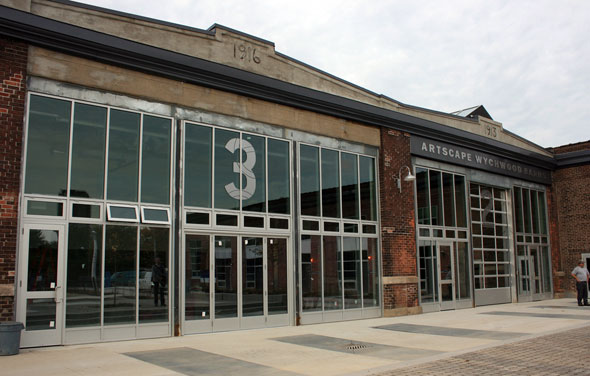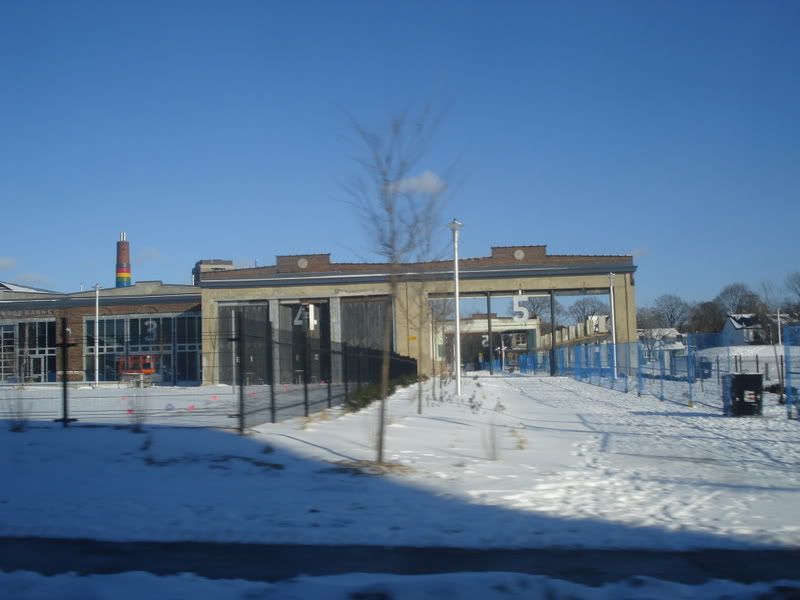ARCHITECTURE: ON THE RIGHT TRACK
A temple in a streetcar shed
The Wychwood barns have all the trappings of an artists' eco-haven. Outdoor bake-oven? Check. Rainwater to flush the toilets? Check. But none of that really matters - it's the soaring design that makes the place feel holy
LISA ROCHON
lrochon@globeandmail.com
Globe and Mail
November 15, 2008
The reinvention of the old Toronto Transit Commission streetcar-maintenance sheds in the St. Clair-Wychwood area of the city will banish forever your spontaneous, ill-considered desire to damn all urbanity and move to Cape Breton. Forget the lobster, this is a chance to feast on a version of urban heaven, a wondrous, hybridized redevelopment of something that had been left for 30 years to die a slow death. The Artscape Wychwood Barns, which open to the public this week, give us a new kind of temple in which art, community and urban agriculture are allowed to happily conspire.
The contemporary flaneur will wander through the complex for hours, possibly days.
Chuck the one-dimensional idea of what the city should be. (And, no, a green roof is no longer a startling idea.) The historic industrial site will be home to affordable artist studios, a performance space for Theatre Direct Canada, offices for groups such as the Hélène Comay Nursery School and the Latino Canadian Cultural Association as well as the Local Enhancement Appreciation of Forests. A large greenhouse, designed by Mike Dixon, a University of Guelph scientist who is also consulting on ways to install greenhouses on Mars, will allow people in the community to be educated year-round about urban agriculture.
Naturally, there is an outdoor bake-oven modelled on the one successfully started in Dufferin Park so many years ago by community leader Jutta Mason. Geothermal heating, which required drilling 50 holes down 120 metres to lay pipes under what is now a playing field, provides the most sustainable form of heat for the complex. Grey water captured from the roofs is being used to flush toilets.
It was not always such a rosy picture. Several years ago, the problem of what to do with the streetcar site, originally built in the early 20th century for the privately run Toronto Civic Railway, polarized the neighbourhood. Some wanted a wide-open park. Others wanted cheap living space. Tim Jones, president and chief executive officer of Artscape, a not-for-profit business dedicated to culture-led regeneration, faced the angry community at meetings that went late into the night. Eventually, over time, he engaged them with possibilities for an adaptive reuse, and his organization was hired in 2004 to redevelop the site.
Artscape had contributed hugely to the reinvention of the Distillery District, where about 60 artists lease studios in the Case Goods Warehouse building. But the presence of parkland surrounding the historic car barns meant unleashing a new kind of dream. And collaboration with the City of Toronto and The Stop Community Food Centre showed the way for a deeply vibrant centre.
A new city park that includes a children's play area and an open sports field surrounds the complex. A natural ice rink - much like the one the community has known since 1925 - will be part of the winter landscape. "There was no shortage of aspiration," says Mr. Jones. "What we've learned about these multi-tenant projects is that the more dynamic the place becomes, the easier it is to raise money, and the more sustainable they become."
Rehabilitated for $21-million, the complex reinvents the existing long, gabled sheds as indoor gallerias and housing for studios. The oldest concrete shed has been sliced back so that its walls open framed views to an organic marketplace and the surrounding park. But before the contemporary interpretation of the architecture could start, the site, contaminated by coal tar, had to be cleaned up. Dalton Company built the redevelopment, with structural consulting provided by Toronto's Blackwell Bowick Partnership. Besides private donations, funding came from the Canadian Heritage's cultural spaces program and the George Cedric Metcalf Charitable Foundation.
The TTC repair barns - some constructed with steel and brick, the others using concrete structures - have been restored and updated in a series of deft, elegant moves by Toronto architect Joe Lobko, a partner with du Toit Allsopp Hillier Architects. In the Studio Barn, an epic skylight runs for 60 metres along the roof of the oldest barn (built in 1913). Where required, muscular black or grey steel frames have been inserted against deteriorated brick entrances or windows. Live-work studios for artists running along Benson Avenue have benefited from new small courtyards defining their front entrances.
There can be no doubt: The Wychwood barns will become the hot cultural destination in the St. Clair and Christie neighbourhood. This is not to say that the barns will replace such major destinations as the Art Gallery of Ontario or the Royal Ontario Museum, because of an enticing bake-oven. The compelling city allows for an intermingling of all creative players. And it's that potent mix which inspires us to stay.







